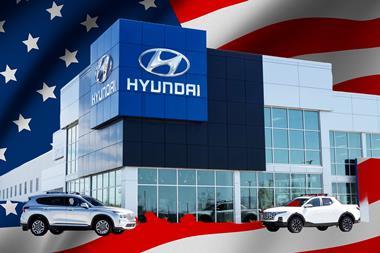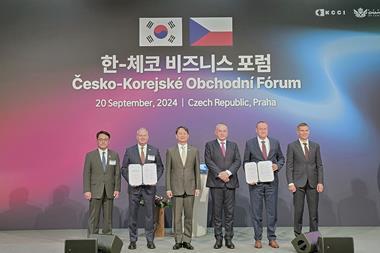Hyundai Motor and Kia have revealed the X-ble Shoulder, a wearable robot aimed at transforming industrial efficiency and reducing workplace injuries. With plans for global expansion and a broader product lineup, the companies are leading innovation in wearable robotics.

Hyundai Motor Company and Kia Corporation have unveiled the X-ble Shoulder, a wearable robot designed to reduce the physical strain of industrial work while increasing productivity. The technology has clear potentials to impact automotive production methods on the shopfloor. Presented at Wearable Robot Tech Day at Hyundai Motorstudio Goyang near Seoul, the X-ble Shoulder marks the debut of Hyundai and Kia’s wearable robotics line.
The X-ble Shoulder combines cutting-edge engineering with user-centric design, according to Hyundai Kia. Developed by the companies’ Robotics LAB, this industrial ‘wearable robot’ reduces shoulder load by up to 60 percent and muscle activity by up to 30 percent.

Lightweight and adaptable, the robot has been tailored to meet the needs of various industries, with obvious vehicle production applications potentially increasing output.
Dong Jin Hyun, Vice Presdient and Head of Robotics LAB at Hyundai Motor and Kia, explained the vision behind the innovation: “The X-ble Shoulder is a wearable robot that leverages the technical capabilities of the Robotics LAB and implements feedback from actual users.
”By pushing technological boundaries, we will make these beneficial products accessible to more people.”
Wearable robotics designed with efficiency and safety in mind
The X-ble Shoulder sets new standards in usability and safety. Built from carbon composite and wear-resistant materials, it offers durability while remaining light enough for extended use. Components that are in contact with the user’s body, says Hyundai Kia, are made from impact-resistant materials, ensuring comfort and safety during operation.
”The adjustable version of the tech, designed for repetitive tasks, is said to be customisable for torque and offers up to 3.7 kgf of support”
The tech’s modular design is said to allow the X-ble Shoulder to integrate seamlessly into various work environments, and potentially into different areas across automotive manufacturing facilities. Its detachable vest is also said to be washable, while its non-powered muscle compensation module eliminates the need for charging, ensuring uninterrupted operation. Hyundai Kia says the robot’s assistive force is generated through a patented multi-link structure, delivering optimal performance tailored to specific tasks.
Martial Law declared in South Korea
Hyundai Kia’s robotics lab, at the Factorial Seongsu building, as well as its Ulsan plant, the world’s single largest automotive production facility, are both located in South Korea.
In early December, the region faced political turmoil as the sitting president, Yoon Suk Yeol, declared Martial Law, upsetting democracy and threatening to impact automitve production in the region.
Read the latest here.
Two versions of the X-ble Shoulder are available. The basic model, ideal for tasks requiring dynamic movement, provides up to 2.9 kgf of assistive force. (Kgf refers to kilogram-force - that is, the force experienced by an object with a mass of 1 kg due to Earth’s gravity). The adjustable version of the tech, designed for repetitive tasks, is said to be customisable for torque and offers up to 3.7 kgf of support. Both models allow a full range of arm motion without hindrance.
The Factorial Seongsu building in Seoul […] employs the Robotics LAB’s delivery robots, EV charging robots, and facial recognition systems to optimise workflows”
Industry applications, market potential and ambitions for robotics leadership
Hyundai and Kia plan to commercialise the X-ble Shoulder by 2025, initially targeting internal use within their production and maintenance departments before expanding to external industries. The companies aim to lead a global wearable robotics market which is projected to grow from $2.55 billion in 2024 to $10.25 billion by 2029, according to Mordor Intelligence.
Hyundai and Kia’s robotics technologies are already being put to use in real-world applications. The Factorial Seongsu building in Seoul, for instance, employs the Robotics LAB’s delivery robots, EV charging robots, and facial recognition systems to optimise workflows. The companies aim to leverage this expertise to expand the X-ble lineup globally by 2026, targeting markets in Europe and North America.






































No comments yet